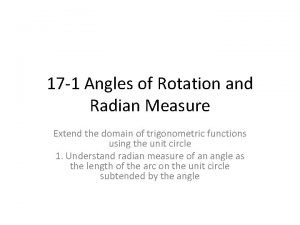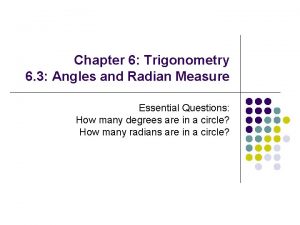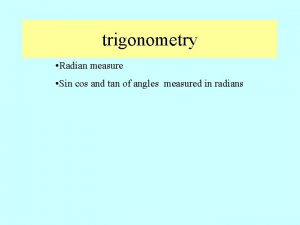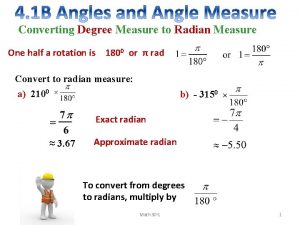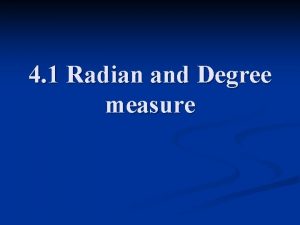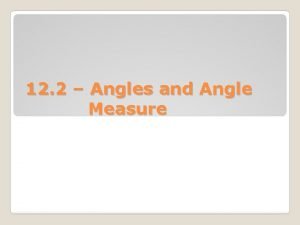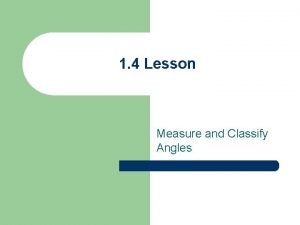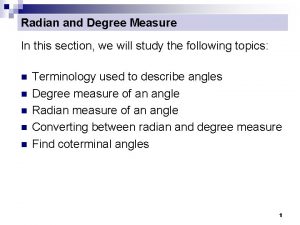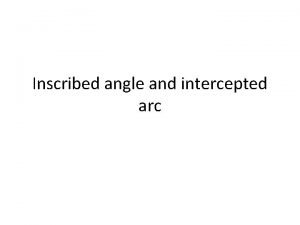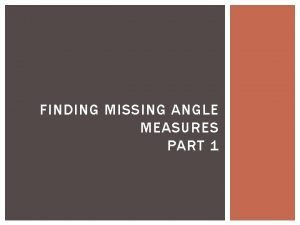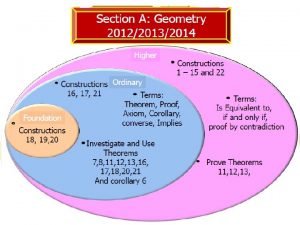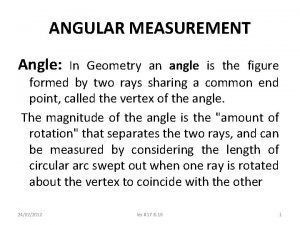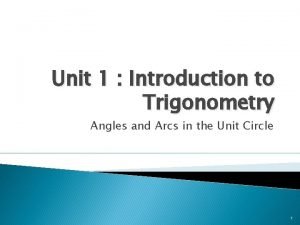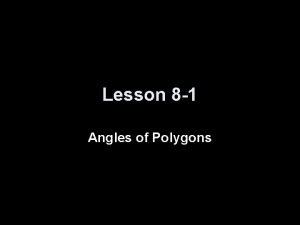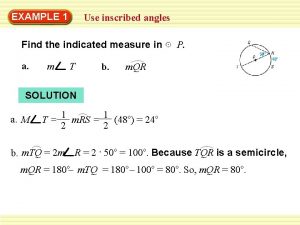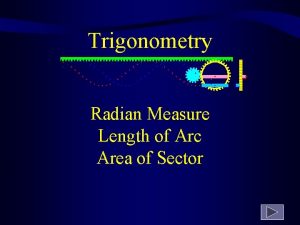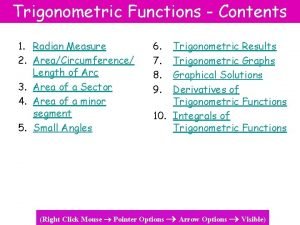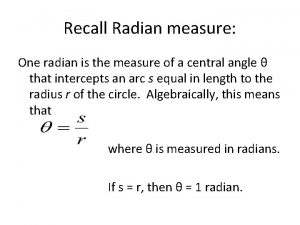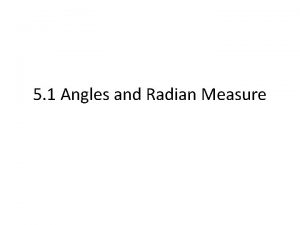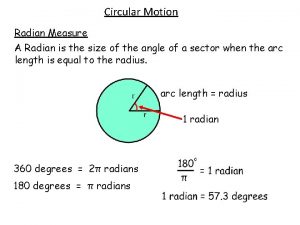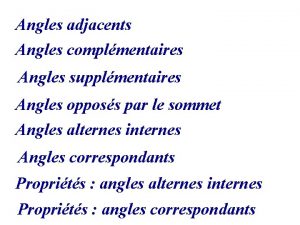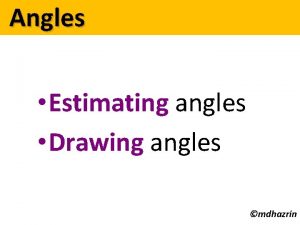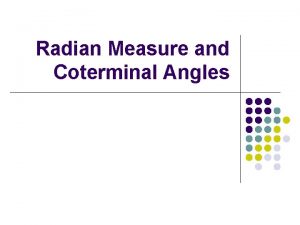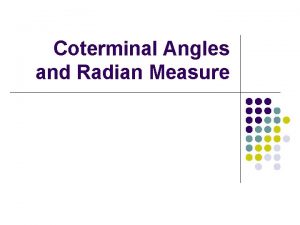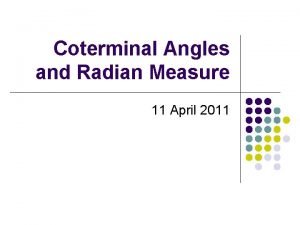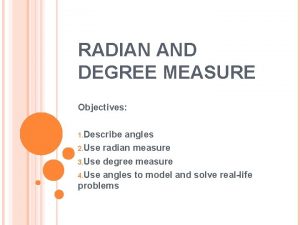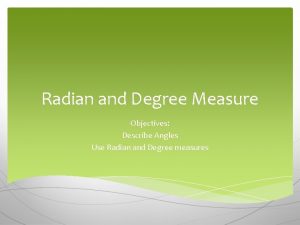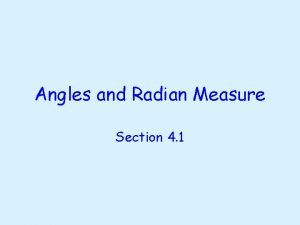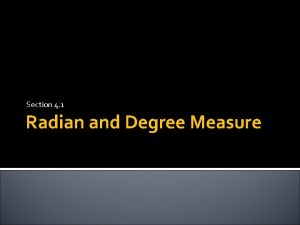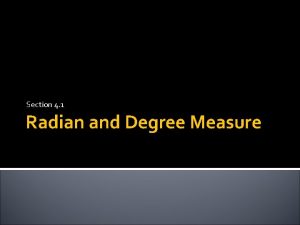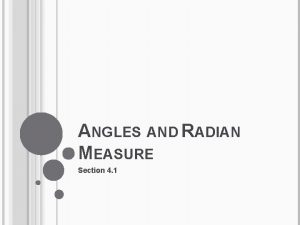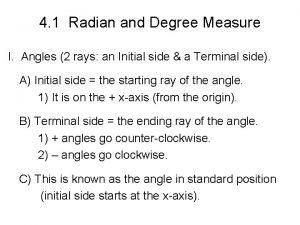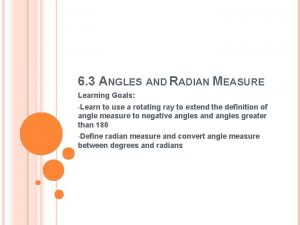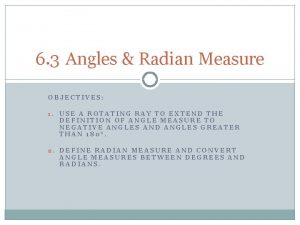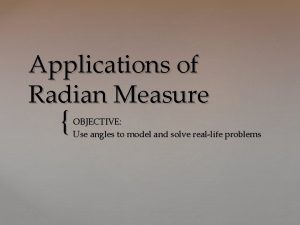Unit 5 Angles and Radian Measure Recognize and
























- Slides: 24

Unit 5 Angles and Radian Measure • • Recognize and use the vocabulary of angles. Use degree measure. Use radian measure. Convert between degrees and radians. Draw angles in standard position. Find coterminal angles. Find the length of a circular arc. Radian Measure as a Distance on the Unit Circle H. Melikian/1200 1

A Sense of Angle Sizes See if you can guess the size of these angles in degrees You will be working so much with these angles H. Melikian/1200 2

Angles An angle is formed by two rays that have a common endpoint. One ray is called the initial side and the other the terminal side. H. Melikian/1200 3

Angles (continued) An angle is in standard position if Ø its vertex is at the origin of a rectangular coordinate system and Øits initial side lies along the positive x-axis. H. Melikian/1200 4

Angles (continued) When we see an initial side and a terminal side in place, there are two kinds of rotations that could have generated the angle. Positive angles are generated by counterclockwise rotation. Thus, angle is positive. Negative angles are generated by clockwise rotation. Thus, angle is negative. H. Melikian/1200 5

Angles (continued) Ø An angle is called a quadrantal angle if its terminal side lies on the x-axis or on the y-axis. Angle is an example of a quadrantal angle. H. Melikian/1200 6

Coterminal Angles Two angles with the same initial and terminal sides but possibly different rotations are called coterminal angles. H. Melikian/1200 7

Example: Finding Coterminal Angles Assume the following angles are in standard position. Find a positive angle less than 360° that is coterminal with each of the following: 400° angle 400° – 360° = 40° b. – 135° angle – 135° + 360° = 225° a. H. Melikian/1200 8

Measuring Angles Using Degrees Angles are measured by determining the amount of rotation from the initial side to the terminal side. A complete rotation of the circle is 360 degrees, or 360°. Ø Ø An acute angle measures less than 90°. A right angle measures 90°. An obtuse angle measures more than 90° but less than 180°. A straight angle measures 180°. Think about the direction and amount of rotation an angle has is a circle. H. Melikian/1200 9

Lets Estimate degrees as a fraction of a circle H. Melikian/1200 10

Suppose a ray is rotated about its endpoint. Give the degree measure of the angle formed if the ray makes: v 360° 300° 900° H. Melikian/1200 11

The degree measure of an angle is given. Determine its fractional part of a complete rotation. v 180 o v 90 o v 45 o v 270 o H. Melikian/1200 12

Complete Figuring out all the Angles Task v Part A H. Melikian/1200 13

Day 2 Warm-up Marissa is running a race on a circular track that has a radius of 200 feet. She is competing against 2 other runners. The coach is at the center and notes each racer’s location after 30 seconds. v H. Melikian/1200 14

Is the Degree the only unit of measurement for angles in a circle? NO! What else? Radians What is a Radian? One radian is the measure of the central angle of a circle that intercepts an arc equal in length to the radius of the circle. Huh? ? What? ? Why? ? H. Melikian/1200 15

Some definitions first…. . A central angle of a circle is an angle with a vertex at the center of the circle. v An intercepted arc is the arc that is “captured” by the central angle. v H. Melikian/1200 16

Radians r v r When the central angle intercepts an arc that has the same length as a radius of the circle, the measure of the angle is defined as a radian. Like degrees, radians measure the amount of rotation from the initial side to the terminal side of the angle. H. Melikian/1200 17

Break down…… v Where does π come from? How many radians (like radius) in a full circle? ? v How many radians in a half circle? ? Number of times the length of the diameter fits around the a circle. Hence C=D π 2π…. or 6. 28 and a little more v π…. or 3. 14 and a little more H. Melikian/1200 18

So what your saying is…… A full circle is 360 ° v Or we could say a full circle is 2π Radians. v A half of a circle is 180 ° v Or we could say a half circle is π Radians. v H. Melikian/1200 19

A Sense of Angles Revisited See if you can guess the size of these angles first in degrees and then in radians. You will be working so much with these angles, you should know them in both degrees and radians. H. Melikian/1200 20

Complete Figuring out all Angles Task Part B H. Melikian/1200 21

Closure: Convert each angle in degrees to radians: a. 60°= b. 270°= c. – 300°= H. Melikian/1200 22

Example: Converting from Radians to Degrees Convert each angle in radians to degrees: a) b) c) H. Melikian/1200 23

Degree and Radian Measures of Angles Commonly Seen in Trigonometry In the figure below, each angle is in standard position, so that the initial side lies along the positive x-axis. H. Melikian/1200 24
 Angles of rotation and radian measure
Angles of rotation and radian measure Vertical angles
Vertical angles Rad sin cos tan
Rad sin cos tan Radian measure
Radian measure 1 radian=
1 radian= Properties of vertically opposite angle
Properties of vertically opposite angle What does a wind vane measure
What does a wind vane measure Draw an angle with the given measure in standard position
Draw an angle with the given measure in standard position Name of the angles
Name of the angles Radian and steradian in antenna
Radian and steradian in antenna Gibbons jacobean city comedy download
Gibbons jacobean city comedy download Module 15 lesson 1 central angles and inscribed angles
Module 15 lesson 1 central angles and inscribed angles Isthmus classification
Isthmus classification Convert from degrees to radians 54
Convert from degrees to radians 54 Intercepted arc example
Intercepted arc example Find the measure of the missing angles
Find the measure of the missing angles Vertically opposite triangles
Vertically opposite triangles Contsine
Contsine Measure of angles
Measure of angles Finding measure of angles
Finding measure of angles Measure of each exterior angle of a regular polygon
Measure of each exterior angle of a regular polygon How to find inscribed angles
How to find inscribed angles Radian area
Radian area Integral of sin cos tan
Integral of sin cos tan Cara menghitung titik koordinat ilmu ukur tanah
Cara menghitung titik koordinat ilmu ukur tanah
